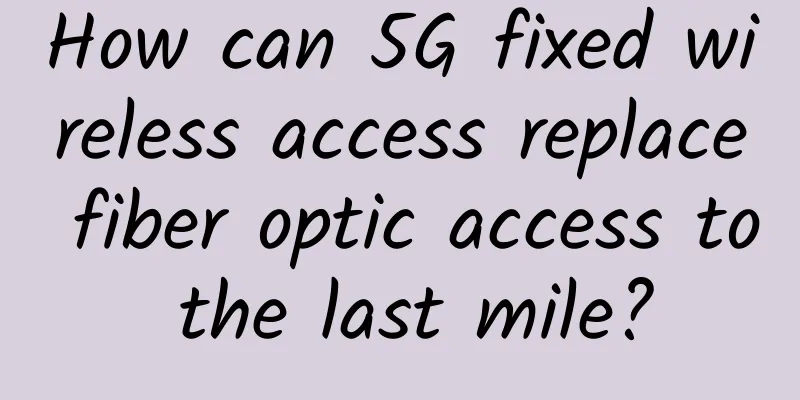How can 5G fixed wireless access replace fiber optic access to the last mile?

|
Verizon, a US operator, announced that it will commercialize 5G fixed wireless access (FWA) in 2017 to replace fiber optic access up to one kilometer. What exactly is FWA? How to build a network? What is the effect? 1 Why do we need FWA? As we all know, the first kilometer access is one of the most complex links in FTTH construction, and it is also the most difficult part. There are obstacles from property management, difficulty in secondary construction, and owners are worried about damage to decoration due to indoor wiring, and the cost of later maintenance is also high. For example, Google Fiber was often complained about for damaging people's gardens when laying optical fibers in the early days due to lack of experience. FWA uses wireless access, has low construction and maintenance costs, and is agile to deploy, making it particularly suitable for homes and small and medium-sized enterprises where fiber optic cables have not yet been delivered. At the same time, since 5G speeds are 10 to 100 times faster than 4G, it can also meet the needs of home broadband. In addition, FWA is not just a replacement for fiber optic access within one kilometer. It actually meets two 5G use cases at the same time: fixed wireless access and enhanced mobile broadband. During the day, it can provide high-speed wireless broadband to nearby mobile users; at night, when people get home from get off work, it can change the beam direction and point to the FWA terminal in the home to provide high-speed Internet access to the home. This makes this technology scalable and sustainable. In fact, in many scenarios, FWA is the only option, such as in rural areas and areas where fiber cannot reach households. In developing countries, only 20% of households have fixed broadband installed. FWA, especially FWA working in low frequency bands (such as 3.5GHz), is a better choice for the remaining 80% of home broadband connections. 2 FWA Wireless Networking The FWA operating frequency band is also the main 5G frequency band currently under consideration, including 3.5GHz, 28GHz, 37GHz and 39GHz, as well as traditional cellular mobile network frequency bands. It uses large-scale beamforming and MU-MIMO technology to improve coverage capabilities and uses high-gain antennas on the terminal side (including indoors and outdoors). The wireless side network structure is as follows... The outdoor part is represented by green, and the indoor part is represented by orange. The FWA base station (RRU+antenna) is connected to the fixed wireless terminal (FWT) deployed on the customer's roof, wall or indoors, and the FWT is then connected to the customer terminal equipment CPE. The FWT is equivalent to providing backhaul for the CPE. 3. 5G-based FWA application scenario test This is the result of Ericsson's test in a suburban scenario. The population density of the suburb is about 1,000 households per square kilometer, and 25% of the households use 4K ultra-high-definition video services, which require a network speed of at least 15Mbps. In this test, the FWA base station (RRU+antenna) is fixed on a 6-meter-high pole, and the FWT terminal antenna is deployed on the roof or outside the wall. The surrounding buildings are about 4-10 meters high. At the same time, there are some 5-15-meter trees around (which may easily cause signal attenuation). The main equipment parameters are as follows: The 5G NR technology used in the experiment has an operating frequency band of 28GHz, a channel bandwidth of 200MHz, beamforming and MU-MIMO technology, and an antenna array of 8x12 cross-polarized antenna units. The test results show that when the network is under low load, the data rate of most users in the area exceeds 800Mbps, and only 11% of users have a data rate below 400Mbps, which is more than enough to cope with 4K ultra-high-definition video that requires a rate of 15Mbps. However, as network load increases, user data rates will decrease due to interference and queuing. The following figure describes that as the network load increases, the proportion of users with speeds greater than 15Mbps and 100Mbps decreases. In this scenario, the maximum traffic per user per month is 5200GB. As shown in the figure above, under high network load, 95% of users can reach a data rate greater than 15Mbps, and 69% of users can reach a rate greater than 100Mbps. Further tests show that the FWT terminal antenna can be installed on the roof, on the wall, or indoors. Considering the loss of wireless signals passing through walls, the FWT terminal antenna can be installed indoors or on the wall near the base station, and on the roof far from the base station. As shown in the figure above, in an area with a station spacing of 350 meters, 78% of FWT terminal antennas can be installed indoors (usually integrated with CPE), 13% of households use wall-mounted installation, and only 5% of households need to install antennas on the roof. 5G fixed wireless access can also adopt a mixed networking method of high and low frequency bands, such as 3.5GHz and 28GHz bands. 3.5GHz provides better wireless coverage. Although the 3.5GHz bandwidth is small, large-scale beamforming and MU-MIMO technology can improve spectrum efficiency and ensure that 3.5GHz provides basic home broadband connections. For 28 GHz, due to the limitation of high frequency propagation characteristics, the coverage is small. The factors affecting its coverage mainly include:
Usually, the FWT terminal antenna is installed on the roof, so that there is a better line of sight between the terminal and the base station, and the effect is better. If the FWT terminal antenna is installed indoors or on the wall, its coverage will be greatly reduced. The height of the base station antenna is higher than the largest tree in the coverage area, which will also improve the coverage of the cell. 4 FWA fronthaul architecture The networking structure of FWA adopts C-RAN architecture, the BBU pool is installed in the central office (CO), and the RRU is remotely located and integrated with the FWA antenna. FWA network architecture diagram Reference: C-RAN Architecture Diagram Compared with traditional macro base station planning, FWA requires base stations to be more densely populated, which is more than 10 times that of traditional macro base stations. As a result, network fronthaul faces capacity challenges. Therefore, it is necessary to redefine BBU and RRU, and separate the PHY, MAC, and RLC layers from BBU to RRU to reduce fronthaul capacity. For example, if a site serves 25 households, and the maximum broadband rate of each household is 1Gbps and the peak rate is 5Gbps, then using the 4G CPRI interface, the fronthaul capacity required for each site is 40-100Gbps; if the PHY layer is sunk to the RRU, the fronthaul capacity required for each site is 10-25Gbps; if the MAC-PHY layer is sunk, the fronthaul capacity required for each site is 5-10Gbps. With the introduction of network structure, mobile network and fixed network are converging in the 5G era. BBU is concentrated in CO (central computer room). In order to reduce latency, the user plane of the core network is moved down to CO. In order to reduce the backhaul burden, CO will deploy content cache servers to form distributed small data centers, which provides more imagination space for 5G FWA applications. At the same time, 5G FWA can also meet the future home AR/VR applications with high latency and capacity requirements. |
Recommend
Yike Cloud: 10% off monthly VPS and 20% off quarterly VPS, starting from 64 yuan/quarter for CN2 lines in the United States/Japan/Hong Kong
OneTechCloud launched a new promotion in March, o...
How Fiber Optic Networks Can Boost Small Business Operations
What is Fiber Optic? This is a form of internet t...
Gigsgigscloud Christmas first month 80% off, Los Angeles VPS first month starting from $1
It's been a long time since there's been ...
Apple and Qualcomm reached a settlement, Intel was eliminated, what is the difficulty in Huawei's must-win 5G baseband chip?
A week ago, Qualcomm and Apple, which had once &q...
The winner of Huawei Ecosystem Partner Elite Competition is finally revealed, and the cloud ecosystem embarks on a new journey
[51CTO.com original article] On October 28, after...
The 10 coolest software-defined networking technologies of 2017
Software is driving the innovation engine of the ...
EtherNetservers: Los Angeles VPS starts at $14.95 per year, 1GB/40GB/1TB, supports Alipay/PayPal
EtherNetservers' special annual VPS has alway...
5 Easy Ways to Check Open Ports on Linux
An open network port is the simplest access point...
What the future of wide area network (WAN) management looks like
The recent surge in the number of employees worki...
5G users will exceed 190 million this year and reach 2.8 billion by the end of 2025
According to a report from Ericsson, by the end o...
Tencent Cloud launches Supermind intelligent network to accelerate global network with cloud as the core
[51CTO.com original article] The application of i...
Huawei's Intelligent IP Network Solution Creates a Simplified 5G Bearer Network
At the HAS Analyst Conference recently, Chen Jinz...
5G sets sail to create China's "speed"
In 2023, 5G applications will enter their final y...
What is blockchain fork? I finally understand
I have previously written about how Bitcoin minin...









